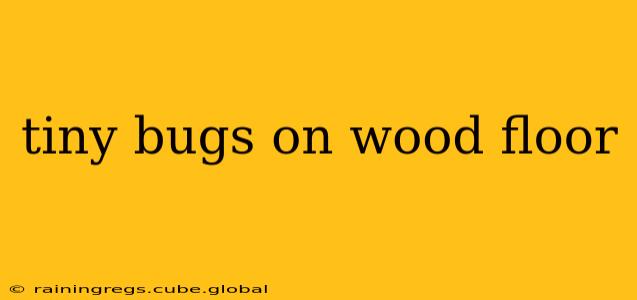Discovering tiny bugs on your wood floors can be unsettling. These uninvited guests can range from harmless to potentially damaging, so proper identification is crucial for effective treatment. This comprehensive guide will help you identify common culprits, understand why they might be infesting your home, and provide solutions for prevention and control.
What Kinds of Tiny Bugs Are Found on Wood Floors?
This is often the first question homeowners ask. Several tiny insects can be found on wood floors, each with its own unique characteristics and preferred habitats. Some of the most common include:
- Dust mites: These microscopic creatures are nearly invisible to the naked eye but can cause significant allergy symptoms. They thrive in dusty environments and feed on dead skin cells.
- Carpet beetles: The larvae of carpet beetles are small, dark-colored, and often found near carpets and rugs, but they can also wander onto wood floors. They feed on natural fibers and can cause damage to carpets, upholstery, and even stored fabrics.
- Silverfish: These wingless insects are silvery-grey and have a distinct teardrop shape. They prefer dark, damp areas and feed on starches and sugars, often found in old books, wallpaper paste, or even dust bunnies accumulating under furniture.
- Booklice: Similar in size to silverfish, booklice are tiny, pale insects that prefer moist environments. They feed on molds, fungi, and starches. While not directly damaging to wood, their presence often indicates a moisture problem in the home.
- Weevils: Certain weevil species, particularly those infesting stored food products, can occasionally wander onto wood floors. These are usually more noticeable than the tiny bugs listed above.
How Do I Identify the Tiny Bugs on My Wood Floor?
Accurate identification is key to effective treatment. Take a close look at the insects:
- Size and Shape: Note the size (are they smaller than a grain of rice?), shape (oval, elongated, etc.), and color.
- Movement: How do they move? Do they crawl quickly or slowly? Do they have wings?
- Location: Where are they most concentrated? Are they near baseboards, under furniture, or evenly distributed across the floor?
- Evidence of Damage: Are there any signs of damage to your wood floors, carpets, or other materials?
Why Do I Have Tiny Bugs on My Wood Floors?
The reasons for tiny bug infestations vary depending on the species:
- Dust and Debris: Accumulated dust and debris provide food and shelter for dust mites, carpet beetles, and booklice. Regular cleaning is crucial for prevention.
- Moisture: High humidity levels can attract insects like silverfish and booklice. Addressing moisture problems, such as leaks or inadequate ventilation, is vital.
- Food Sources: Carpet beetles feed on natural fibers, while booklice and silverfish feed on starches and other organic materials. Proper storage of food and removal of clutter are essential.
What Can I Do to Get Rid of Tiny Bugs on My Wood Floors?
The best approach depends on the type of insect. However, here are some general recommendations:
- Thorough Cleaning: Vacuum and mop your floors regularly to remove dust, debris, and insect food sources.
- Moisture Control: Repair any leaks, ensure adequate ventilation, and use dehumidifiers to reduce humidity levels.
- Pest Control: For persistent infestations, consider using insecticides or contacting a pest control professional. Choose products specifically designed for the type of insect you've identified.
- Preventative Measures: Regular cleaning, decluttering, and moisture control are the best ways to prevent future infestations.
Are Tiny Bugs on Wood Floors Harmful?
The harm posed by tiny bugs varies greatly depending on the species:
- Dust mites: Primarily cause allergic reactions in susceptible individuals.
- Carpet beetles: Primarily cause damage to fabrics and carpets.
- Silverfish and booklice: Generally considered harmless but can indicate moisture problems.
How Can I Prevent Tiny Bugs From Infesting My Wood Floors?
Proactive measures are far more effective than reactive treatments:
- Regular cleaning: Vacuum and mop frequently.
- Decluttering: Remove unnecessary items that could provide food or shelter.
- Moisture control: Address any sources of moisture and ensure adequate ventilation.
- Regular inspections: Check your floors regularly for signs of infestation.
By understanding the various types of tiny bugs that can infest your wood floors, their habits, and effective control methods, you can keep your home pest-free and maintain a healthy living environment. Remember, early detection and preventative measures are your best allies in this battle!
